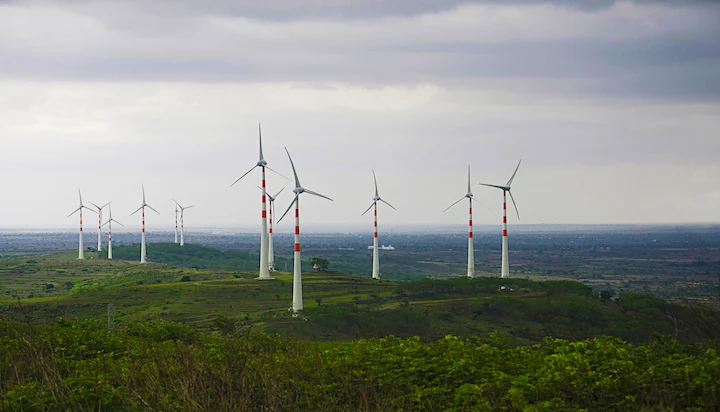As on date, India is the third largest GHG emitter in the world, after China and the US. It emits about 3 gigatonnes (Gt) CO2eq of greenhouse gases each year; about 2.5 tons per person, which though is less than the world average, it accounts to approx. 7 per cent of the annual global emissions, despite having only 17 per cent of the world population. This emphasises the facts that substantial population of the country still lags minimum basic commercial energy supply; poses an unique challenge.
India’s emissions have risen by an annual average value of 5.6 per cent, to reach 2.6 Billion tons of CO2 eq in between 2010 and 2018. Within this, Energy sector is the largest GHG emitter in India, accounting for 68 – 70 per cent of annual emissions. This is followed with agriculture, industrial processes, land-use change and forestry.
There is clearly a dire need to adopt clean energy sources like renewables that do not emit greenhouse gases while being energy efficient. The government plans to introduce amendments to the Energy Conservation Act will not only enable the much needed positive change to the environment but it will also provide a regulatory framework for carbon trading in India which will in-turn further encourage the consumption of renewables.
Investments in Clean Energy is an investment in the planet’s future
As the world population continues to grow, energy and renewable sources are the perfect tools to transition sustainable energy solutions, while also protecting the planet from climate change. Since renewable energy sources do not emit greenhouse gases such as carbon dioxide, they also do not contribute to global warming help ensure that climate change is not advanced.
Renewable including wind power, hydro, solar, bio-energy, geothermal etc. enables in the preservation of the world’s natural resources while also reducing the risk of environmental disasters like fuel spills or the problems associated with natural gas leaks. Renewable energy can be used for a variety of different applications, from electricity generation to heating water and more, depending on the source of the energy.
Renewable energy with its enhanced employability factor has a direct positive impact on livelihoods. With enhanced electrification of end-use energy usage renewable energy appears to be the future for the power needs of humanity across the globe as reliance of fossil fuels continues to diminish. As the drive towards clean, green and renewable energy continues to advance, the cost will fall and work will be created to develop and install these new power solutions.
Ensuring seamless energy storage and supportive policies for green hydrogen is critical to help accelerate the roll-out of clean energy technologies in the country and help decarbonise not just the electricity sector but also other hard-to-abate sectors like fertiliser production and petroleum refining.
More and more countries across the globe are now recognising the environmental, societal and economic benefits of clean energy and, as more nations sign up to a green power agenda, the transition to clean energy will continue to advance even in India.
Currently, factors like the ever-rising electricity demand, falling prices of renewable energy alternatives, and government support in terms of various incentives and schemes are currently some of the key drivers of India’s clean energy growth right now. This trend however needs support from the government to gather further steam.
Energy Conservation Act 2001
The Government of India enacted the Energy Conservation Act 2001 with an aim to redeem the country’s potentials for energy saving and conservation which has the capability to create an equivalent capacity of a minimum of 25000 MW. The Act provides the legal framework, institutional arrangement and a regulatory mechanism at the Central and State level for the efficient use of energy and its conservation. Under this Act, the Bureau of Energy Efficiency (BEE) was established in March 2002 for the implementation of policies and programmes with the primary objective of reducing the energy intensity in the Indian economy through energy conservation activities.
An amendment to this Act warrants a firm thrust on the improvement of energy efficiency while generating new capacities. It needs to aim for further lowering the energy intensity of our economy given that our oil and natural gas reserves are meager even as our imports continue to be high. A higher dependence on imports will affect our energy security. The amends will also boost the adoption of clean technologies in various sectors of economy. The provisions would facilitate the promotion of clean energy sources like green hydrogen as an alternate to the existing fossil fuels used by industries currently.
The proposed amendments will also facilitate the development of carbon market in India with its regulation on the minimum consumption of energy which will in turn help in the reduction of fossil fuel based energy consumption and carbon emission into the atmosphere. The additional incentives in the form of carbon credits against deployment of clean technologies will result in the proliferation of the carbon credit industry with more players, leading to increased climate actions.
The amendments will empower the country to increasingly strive towards its net-zero commitment of 2070 with the further implementation of NDCs in a timely manner.
The Future
India has massive renewable energy potentials. The country not only needs to make a seismic shift from fossil fuels to renewable energy, but also has new incremental demand that needs to be met through additional renewable energy capacity. India needs to build an entire ecosystem for clean energy which involves initiatives to address the variability of renewable by addressing flexible and decentralised generation and storages technologies like rooftop solar, battery storage, pumped hydro and green hydrogen; promotion end use electrifications like induction cooking, electric vehicles, modal shift from road to rail etc.
The Indian government has rolled out policies and reforms to facilitate the growth of the renewable energy sector and is now facilitating investment in other clean technologies, such as energy storage, green hydrogen, energy efficiency and electric mobility.
Source: businessworld.in









